Latest posts by (see all)
- The Best Things to Do in Tulsa - June 26, 2020
- The Most Interesting Things to Do in Springfield Mo - June 15, 2020
- Best Things to Do in Salt Lake City - May 26, 2020
- 10 Best Websites for Playing Online Games - May 22, 2020
 Europe is a great place for tourism. It has survived many wars, political intrigues, epidemics and became what we can see it now. Great history, beautiful nature, cultural heritage and versatility are manifested in the famous sights of Europe. Travelers are attracted by the stained-glass cathedrals, the ski slopes and museums. Holidays in Europe are associated with the diversity, riddles, beauty … What to see in Europe? The stone mystery in England – Stonehenge – is testing the best minds of scientists for strength and striking with its unimaginable grandeur, attracting many tourists who want to come in contact with the unknown.
Europe is a great place for tourism. It has survived many wars, political intrigues, epidemics and became what we can see it now. Great history, beautiful nature, cultural heritage and versatility are manifested in the famous sights of Europe. Travelers are attracted by the stained-glass cathedrals, the ski slopes and museums. Holidays in Europe are associated with the diversity, riddles, beauty … What to see in Europe? The stone mystery in England – Stonehenge – is testing the best minds of scientists for strength and striking with its unimaginable grandeur, attracting many tourists who want to come in contact with the unknown.
The most famous monument of architecture of Ancient Rome is the Coliseum in present-day Rome. The beautiful and impressive stadium of the ancient world is a true symbol of Rome and its history, as well as the progenitor of the present theater. According to the scenes from the films, roaring tribunes are presented, which gladiators fight with delight. Although at the same time for the filming of gladiator films the Coliseum is not used, since, unfortunately, it is not well preserved. That’s why the role of the Colosseum in the cinema is usually performed by the amphitheater of Mark Gordian in the city of Tisdra. And such a landmark of Europe as the amphitheater in Verona, thanks to its exceptional acoustics, is still used for concert and opera productions.
The list of interesting places to visit in Europe is really endless but the lack of time makes us choose only the best places. That’s why here you are offered to enjoy the impressive virtual trip around the most beautiful places, which you should definitely see.
Contents
- Place to visit number 1: Saint Angel Castle, Italy
- Place to visit number 2: Mount Montserrat, Spain
- Place to visit number 3: The castle of Rosenborg and its treasury, Denmark
- Place to visit number 4: The Artus Court, Poland
- Place to visit number 5: St. Anastasia Island, Bulgaria
- Place to visit number 6: The Bergen Art Museum KODE, Norway
- Place to visit number 7: Cannes Palace of the Film Festival, France
- Place to visit number 8: Cape Cabo da Roca, Portugal
- Place to visit number 9: The John Rylands Library, Great Britain
- Place to visit number 10: The Castle Drottningholm, Sweden
- Video
Place to visit number 1: Saint Angel Castle, Italy
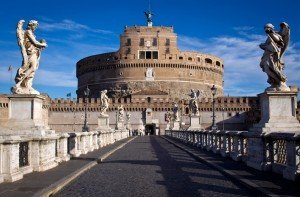 Among the sights of Rome, a visit to the Castle of Saint Angel can certainly be the most exciting experience. This fortress was originally built as a tomb, and nowadays it is a fascinating labyrinth consisting of 58 rooms. The fate of the castle of Saint Angel is very interesting and complex. According to the legend it has the name “Castle of the Holy Angel” since 590 after the procession of Pope Gregory the Great passed through the city streets. Then the epidemic of plague raged in the city. The angel was sheathed in the scabbard to the prayers above the tomb. People interpreted this phenomenon as God’s mercy, and soon the epidemic ceased, and after a while on the roof of the mausoleum, a statue of an angel was installed. Over the long period of time of its existence, it managed to stay both
Among the sights of Rome, a visit to the Castle of Saint Angel can certainly be the most exciting experience. This fortress was originally built as a tomb, and nowadays it is a fascinating labyrinth consisting of 58 rooms. The fate of the castle of Saint Angel is very interesting and complex. According to the legend it has the name “Castle of the Holy Angel” since 590 after the procession of Pope Gregory the Great passed through the city streets. Then the epidemic of plague raged in the city. The angel was sheathed in the scabbard to the prayers above the tomb. People interpreted this phenomenon as God’s mercy, and soon the epidemic ceased, and after a while on the roof of the mausoleum, a statue of an angel was installed. Over the long period of time of its existence, it managed to stay both
the burial vault, the fortress, and the residence of the Pope, and even serve as a “storehouse of the Catholic Church.” Separate premises on the ground floor, as well as the dungeons of the castle, have for some time been used as a prison:
- Here the conspirators were kept in custody against the Pope,
- here the scientists Giordano Bruno and Galileo were imprisoned,
- and in December 1789, Count Cagliostro, accused of the heresy, was placed in a punishment cell.
Interesting: Only one person managed to escape from prison – it was Benvenuto Cellini – the most famous sculptor and author of memoirs, famous not only for his works, but also for this escape.
Place to visit number 2: Mount Montserrat, Spain
![Montserrat_des_de_Manresa[1]](https://www.43places.com/wp-content/uploads/2017/05/Montserrat_des_de_Manresa1-300x200.jpg) Mount Montserrat is located 50 kilometers from Barcelona. Here you can see the famous monastery of the same name.
Mount Montserrat is located 50 kilometers from Barcelona. Here you can see the famous monastery of the same name.
The mountain has unusual, bizarre outlines:
- huge rocks, reminiscent of idols,
- channeling canals,
- mysterious caves.
The unparalleled charm of Montserrat inspired musicians, artists and poets to create masterpieces.
According to the legend, this mountain is the palace of the Mother of God, the ancient black statue of which is the main shrine of Catalonia, is located here. People go to the mountain not only to admire the amazing natural phenomenon, but also ask the Black Madonna, famous for its miraculous power, health, a successful marriage and especially children.
Montserrat can be reached by train, bus or car.
Interesting: A cable car and a mountain train lead to the mountain, and funiculars go to the top. In total, there are about ten hiking trails.
Place to visit number 3: The castle of Rosenborg and its treasury, Denmark
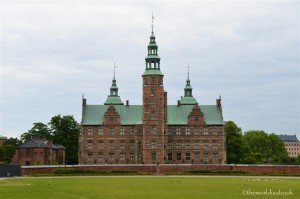 On the outskirts of Copenhagen there is a castle called Rosenborg. The castle begins its history in 1606 – then the park zone was founded, in the territory of which later a small two-story mansion appeared. Over the next twenty years, the mansion has grown to an incredible size, and from a small country house it has turned into a real chic castle. The main entrance to the castle was completed only by 1634 – its opening was timed to the wedding day of Prince Frederick III with Princess Magdalena Sybil. Since 1838 and to this day in Rosenborg a royal museum operates, unique exhibits of which tell of the 300-year history of the Oldenburg royal dynasty. Rosenborg surrounds the magnificent Garden of Kings. Interesting: The castle also has a royal treasury, in which the most precious relics of Rosenborg are kept.
On the outskirts of Copenhagen there is a castle called Rosenborg. The castle begins its history in 1606 – then the park zone was founded, in the territory of which later a small two-story mansion appeared. Over the next twenty years, the mansion has grown to an incredible size, and from a small country house it has turned into a real chic castle. The main entrance to the castle was completed only by 1634 – its opening was timed to the wedding day of Prince Frederick III with Princess Magdalena Sybil. Since 1838 and to this day in Rosenborg a royal museum operates, unique exhibits of which tell of the 300-year history of the Oldenburg royal dynasty. Rosenborg surrounds the magnificent Garden of Kings. Interesting: The castle also has a royal treasury, in which the most precious relics of Rosenborg are kept.
Place to visit number 4: The Artus Court, Poland
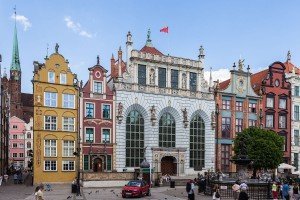 This is a medieval stone building complex that stands on the main Town Hall Square near the Neptune Fountain. Its name came directly from knightly times: the prototype of such courts was a legend about the court of King Arthur and the Round table. Such houses traditionally arose in the Baltic cities of the Hanseatic League, among which Gdansk was. Famous citizens and authorities met here, merchant unions and courts met, and festivals with concerts, theatrical productions and feasts were held here. It was a kind of secular salon for members of the elite and at the same time – the epicenter of commercial life at the highest level. In the 19th century, important people were invited to the Artus Court and various celebrations were held.
This is a medieval stone building complex that stands on the main Town Hall Square near the Neptune Fountain. Its name came directly from knightly times: the prototype of such courts was a legend about the court of King Arthur and the Round table. Such houses traditionally arose in the Baltic cities of the Hanseatic League, among which Gdansk was. Famous citizens and authorities met here, merchant unions and courts met, and festivals with concerts, theatrical productions and feasts were held here. It was a kind of secular salon for members of the elite and at the same time – the epicenter of commercial life at the highest level. In the 19th century, important people were invited to the Artus Court and various celebrations were held.
Gdansk Court of Artus was built in 1350. It consists of the actual yard and two Barn Houses – old and new. They are united by a common ground floor. In 1476 the yard was badly damaged by the fire, and during the next year it was restored, having acquired characteristic Gothic features. The facade of the courtyard was redesigned by Abraham Van den Block and looks rather sumptuous and pompous today, standing out against the backdrop of House of Bench – typical bourgeois houses. This is a beautiful light building with three naves and four graceful columns. The interior of it is amazing and rich.
Here you will see:
- Hundreds of art and crafts collected over a period of several centuries;
- Among them, there is a sculpture of the patron saint of the trading fraternities of St. George during the battle with the dragon;
- a masterpiece of late Gothic;
- a beer rack, created in the 16th century from tin, which is the oldest bar in the country;
- Here you can find a collection of ancient weapons and armor, as well as a collection of ancient models of ships, similar to which there is no in the whole world.
Alas, the paintings that adorn the central hall with carved wooden benches are just a computer reconstruction. The originals were lost during the Second World War.
Particular attention in the courtyard is attracted by the largest oven in Europe, made in the 16th century by G. Shtetsenar and finished with painted tiles. The height of the furnace exceeds 10 meters, and it consists of five tiers.
Interesting: The decoration of the “King of Stoves” took 520 hand-made tiles, bright and detailed, with images of angels and eminent personalities, coats of arms, mottos, celestial bodies, mythological figures, portraits of European rulers and kings of Poland.
Place to visit number 5: St. Anastasia Island, Bulgaria
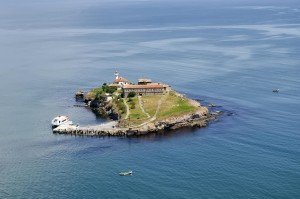 This is an island with a long history, which is located one and a half kilometers from Chernomorets, in the Black Sea – more precisely in the Burgas Bay. Although its territory is only a hectare, this rocky island is about 12 m high above the water level is the only inhabited island in the Bulgarian part of the Black Sea.
This is an island with a long history, which is located one and a half kilometers from Chernomorets, in the Black Sea – more precisely in the Burgas Bay. Although its territory is only a hectare, this rocky island is about 12 m high above the water level is the only inhabited island in the Bulgarian part of the Black Sea.
The island of St. Anastasia is the only island in Bulgaria where the monastery was opened. The monastery appeared here around the 15th century (although, perhaps, earlier), but to our days only one Ascension church remained from it.
There are several various legends about this place:
- According to the first one, the island was raided by pirates, but St. Anastasia, listening to the prayers of monks, destroyed a pirate ship. Its fragments are permanently petrified in the rock and can be demonstrated to tourists.
- According to another version, the pirates have failed a ghost guarding the treasures buried on the island.
- The last legend says that on the island there are catacombs, only the entrance to them is disguised so skillfully that no one can get there now.
Interesting: In 2001, the island was declared a natural and archaeological reserve.
Place to visit number 6: The Bergen Art Museum KODE, Norway
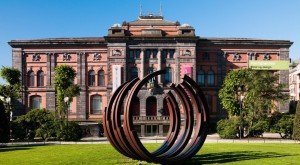 KODE is located in the heart of the city on the banks of the Bergen lake and directly opposite the city park. There are four of its buildings, which from the spring of 2013 are designated as KODE-1, KODE-2 and so on. In general, this is one of the largest museums in the Nordic countries. KODE collections include various masterpieces of world art, from the Renaissance to the present.In 2006, KODE united in itself not one, but as many as five museums.
KODE is located in the heart of the city on the banks of the Bergen lake and directly opposite the city park. There are four of its buildings, which from the spring of 2013 are designated as KODE-1, KODE-2 and so on. In general, this is one of the largest museums in the Nordic countries. KODE collections include various masterpieces of world art, from the Renaissance to the present.In 2006, KODE united in itself not one, but as many as five museums.
The history of the museum is long and solid. The decision to organize an art museum was made in 1825, and in 1887 the Museum of Applied Arts was opened in the city. Today there are about 43,000 items in the united KODE collection.
These are:
- paintings,
- drawings,
- sculptures,
- Installations,
- video recordings.
An impressive part of them came to the museum from private collectors. For example, this was the collection of the Chinese collection, the items of which were regularly handed over to the museum by General Münkhe between 1907 and 1935 (the exposition was closed after robbery in early 2013). And the Silver Treasury was completely transferred to the museum in 2007. About 600 amazing gold and silver objects are included in the collection.
Serious changes began in 2006, when KODE united in itself not one but five museums:
- the house-museum of Edward Grieg of Trollhaugen,
- the museum of Harald Severud,
- the museum of Ole Bull,
- the very first – the Bergen Art Museum,
- the West Norwegian Museum of Applied Art.
Visit all the buildings of KODE can be on a single ticket, which is valid for two days. In order to be easier to navigate between the four KODE buildings, it is enough to know the basic vectors:
- KODE-1 – the former Museum of Applied Art of Western Norway. Collection of Chinese art, Silver treasury, an exhibition of objects of design, arts and crafts for the past half a millennium and temporary exposition.
- KODE-2 – the collection of Stenerersens. Modern art, permanent and temporary exhibitions, the largest museum store on the ground floor next to the cafe.
- KODE-3 is a collection of Rasmus Mayer. One of the richest collections of works by Edvard Munch in the world, as well as samples of Norwegian art of the 18-19th centuries.
- KODE-4 – a large and old permanent exhibition of paintings, ranging from Klee and Picasso and ending with Miro and Dali, as well as an exhibition of works by Norwegian Nikolai Astrup.
Interesting: There is also a separate “museum in the museum”: KunstLab.
Place to visit number 7: Cannes Palace of the Film Festival, France
 Once a year, the Palais des Festivals in Cannes becomes the most popular place in the world. Almost everyone heard about the famous film festival, watched broadcasts from the Avenue of Stars, watched as in the rays of soffits actors with a world name climb the legendary 24 steps, covered with a red carpet. As a rule, this concludes the knowledge of the palace: very few people even imagine what it looks like. Meanwhile, it is one of the largest entertainment and business centers in France, striking not only advanced technical equipment, but also causing fierce disputes in appearance.
Once a year, the Palais des Festivals in Cannes becomes the most popular place in the world. Almost everyone heard about the famous film festival, watched broadcasts from the Avenue of Stars, watched as in the rays of soffits actors with a world name climb the legendary 24 steps, covered with a red carpet. As a rule, this concludes the knowledge of the palace: very few people even imagine what it looks like. Meanwhile, it is one of the largest entertainment and business centers in France, striking not only advanced technical equipment, but also causing fierce disputes in appearance.
Without the famous Cannes Film Festival, the palace would never have been built. Despite its high status, the first post-war festival in 1946, in the absence of a special building, was held in an ordinary casino on the city embankment. The Cannes City Hall did not want to put up with this state of affairs and in 1949 artists from all over the world took on a new Palace of Festivals (at that time it was more often called “Croisette”). Look at the former building of the palace is no longer possible – it was demolished, and now in its place there is the hotel network “Marriott” (also the “palace of Stephanie”).
Over the years, the popularity of the “Golden Palms” grew exponentially, and the old Croisette Palace became simply small for such an event. The problem was solved no less radically than after the war: in 1979 the city casino near the
Old Port was demolished, and in its place a new grandiose building was erected – the modern Palace of Festivals.
The full name of the attraction is the Cannes Palace of Festivals and Congresses. This small addition to the old name is not accidental – in the second half of the 20th century, business tourism in Provence was experiencing a real boom, and the city was in dire need of a business center equipped with the latest technology. The project of the architects Bennett and Drewe was focused primarily on convenience and functionality – therefore, outflanked by competitors. Although the locals do not like the palace and scornfully refer to it as a bunker, but its guests are happy with the new building (or rather, a whole complex of buildings with auditoriums, halls, press rooms and even a casino).
The Cannes Palace is designed in such a way that it is convenient for everyone:
- lighters and sound engineers,
- film stars and producers,
- journalists and businessmen,
- electricians and security.
Interesting: There is more than 30,000 sq. meters of the beautifully designed and organized space.
Place to visit number 8: Cape Cabo da Roca, Portugal
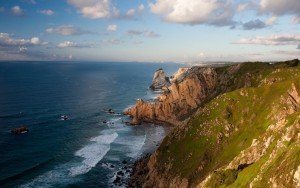 Cape Roca is the westernmost point of Europe. At the top of the cliff of Cape Cabo da Roca, towering 140 meters above the waters of the Atlantic, there is a lighthouse marking the outermost point of the Eurasian continent. The cape is 40 km west of Lisbon and 18 km from Sintra.
Cape Roca is the westernmost point of Europe. At the top of the cliff of Cape Cabo da Roca, towering 140 meters above the waters of the Atlantic, there is a lighthouse marking the outermost point of the Eurasian continent. The cape is 40 km west of Lisbon and 18 km from Sintra.
It is located in the Sintra-Cascais National Park.
Some interesting things you should know about this place:
- In ancient times, the Romans called this promontory “Promontorium Magnum”, and in the Age of Great geographical discoveries, it bore the names “Lisbon”.
- Translated from the Portuguese name “Cabo da Roca” means “Stone Cape”.
Landscapes that open from this point will impress even the most sophisticated travelers.
Interesting: At the lighthouse there is a post office and a souvenir shop where you can buy a small copy of a lighthouse or a piece of painted ceramic tiles.
Place to visit number 9: The John Rylands Library, Great Britain
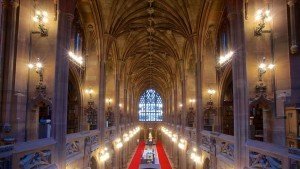 The John Rylands Library is located in the center of Manchester in a beautiful neo-Gothic building. The library was opened in 1900 by Mrs. Enriqueta Augustine Rylands in the memory of her deceased husband. Her husband John Rylands was a famous British businessman and philanthropist, owner of the largest textile company in the United Kingdom and the first multimillionaire in Manchester. The building was built according to the project of the architect Basil Chapnis. Since it was supposed that the library would specialize in theological literature, the building in many respects resembles a Gothic church. Manchester at that time was a large industrial city, suffering from smog, smoke and air pollution. To protect books from harmful substances, the building was equipped with a very complicated ventilation system with water filters and electric fans, which for that time was the best solution. The library was lit not by gas lamps, but by electric, because they do not pollute the air, they give more light and are safer.
The John Rylands Library is located in the center of Manchester in a beautiful neo-Gothic building. The library was opened in 1900 by Mrs. Enriqueta Augustine Rylands in the memory of her deceased husband. Her husband John Rylands was a famous British businessman and philanthropist, owner of the largest textile company in the United Kingdom and the first multimillionaire in Manchester. The building was built according to the project of the architect Basil Chapnis. Since it was supposed that the library would specialize in theological literature, the building in many respects resembles a Gothic church. Manchester at that time was a large industrial city, suffering from smog, smoke and air pollution. To protect books from harmful substances, the building was equipped with a very complicated ventilation system with water filters and electric fans, which for that time was the best solution. The library was lit not by gas lamps, but by electric, because they do not pollute the air, they give more light and are safer.
The basis of the collection was 40 000 volumes, collected by George John Spencer and bought from him. Here there are the rarest books kept:
- the first printed Bible of Gutenberg,
- a fragment of the earliest New Testament,
- а collection of papyri,
- an apocryphal gospel from Mary,
- and many others.
Interesting: In 1972, the library merged with John Rylands and the library of Manchester University.
Place to visit number 10: The Castle Drottningholm, Sweden
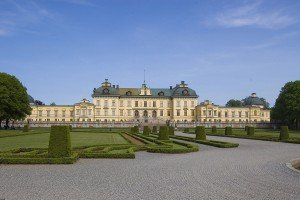 “Queen’s Island”, the castle Drottningholm is often called Versailles in miniature, and for this there are all grounds. The magnificent residence of the Swedish monarchs on the picturesque lake Malaren boasts luxurious interiors,
“Queen’s Island”, the castle Drottningholm is often called Versailles in miniature, and for this there are all grounds. The magnificent residence of the Swedish monarchs on the picturesque lake Malaren boasts luxurious interiors,
its own theater, a fabulous Chinese pavilion and a well-kept park with numerous sculptures and fountains – and thanks to all this wealth since 1991 it has appeared on the UNESCO List.
The history of Drottningholm Castle begins in the 16th century, when on the island in the middle of Lake Malaren the Swedish King Johan III ordered to build a palace for his wife.
What to see here? Carefully reconstructed historic interiors are the main pride of Drottningholm Castle. It is worth paying special attention to:
- the Parade Hall,
- the boudoir of Queen Eleonora,
- the library richly decorated with gilded stucco, valuable fabrics and carved wooden panels.
Interesting: Drottningholm Castle is surrounded by a vast park – one part is divided according to the canons of French baroque and presents numerous sculptures of the Dutch sculptor Adrian de Vries, the second – an English garden with lawns, ponds, canals and bridges.
Back